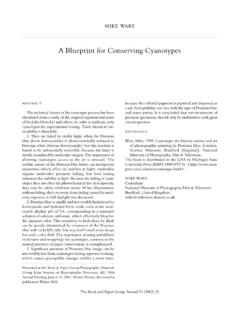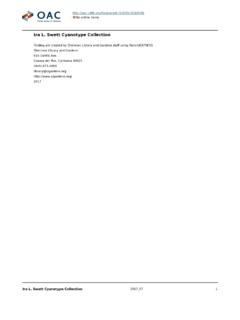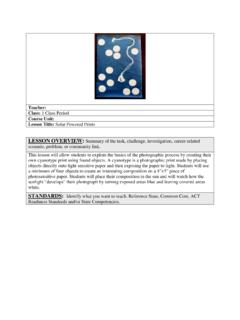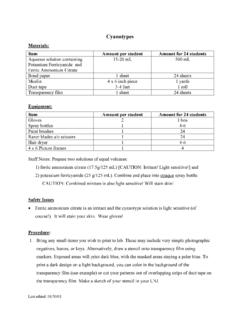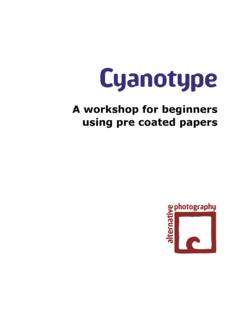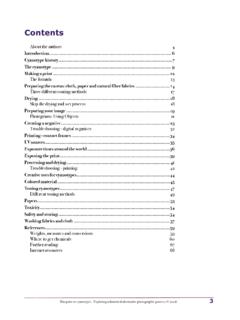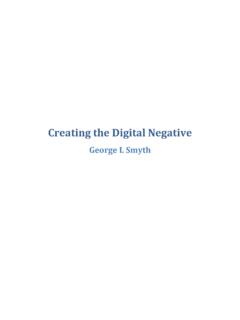Transcription of Cyanotypes Author(s): Topics in Photographic Preservation ...
1 Article: The Effects of Acidic, Alkaline, Buffered, and Non-Buffered Enclosures on Cyanotypes Author(s): Lauren Held, Daniel Burge, and Douglas Nishimura Topics in Photographic Preservation , Volume 14. Pages: 237 - 249 Compilers: Camille Moore and Jessica Keister 2011, The American Institute for Conservation of Historic & Artistic Works. 1156 15th St. NW, Suite 320, Washington, DC 20005. (202) 452-9545, Under a licensing agreement, individual authors retain copyright to their work and extend publication rights to the American Institute for Conservation. Topics in Photographic Preservation is published biannually by the Photographic Materials Group (PMG) of the American Institute for Conservation of Historic & Artistic Works (AIC).
2 A membership benefit of the Photographic Materials Group, Topics in Photographic Preservation is primarily comprised of papers presented at PMG meetings and is intended to inform and educate conservation-related disciplines. Papers presented in Topics in Photographic Preservation , Vol. 14, have not undergone a formal process of peer review. Responsibility for the methods and materials described herein rests solely with the authors, whose articles should not be considered official statements of the PMG or the AIC. The PMG is an approved division of the AIC but does not necessarily represent the AIC policy or opinions. Topics in Photographic Preservation , Volume Fourteen (2011) 237 THE EFFECTS OF ACIDIC, ALKALINE, BUFFERED, AND NON-BUFFERED ENCLOSURES ON Cyanotypes LAUREN HELD, DANIEL BURGE, AND DOUGLAS NISHIMURA ABSTRACT The purpose of this experiment was to determine whether the belief that cyanotype prints will be adversely affected by buffered enclosures in long-term storage is truly valid.
3 This assumption has been supported by anecdotal reports, experiments with alkalis on Prussian Blue, and experiments with calcium carbonate paste directly on cyanotype prints. The effect is not known to have been established experimentally using actual, commercial buffered and non-buffered storage papers (interleave tissues, envelope papers, folder stocks etc.). Also, contrary to the above, it has been theorized that since calcium carbonate buffering is in a mostly solid form in paper (it has a low solubility and the moisture content of paper is typically very low), it is not likely to be reactive with the cyanotype colorants (or other imaging colorants such as chromogenic dyes or binders such as albumen).
4 In fact, ISO 18902 Imaging materials -- Processed imaging materials -- Albums, framing and storage materials now recommends the use of buffered papers for storage of all Photographic materials; however, Cyanotypes are not specifically discussed. Archival suppliers would prefer to stock only buffered papers as they are more widely used. In addition, it is becoming more difficult for suppliers to find paper mills willing to produce high-quality non-buffered papers. It would also make it easier on institutions if one enclosure paper could be used for most if not all print types. These contradictions between theories, experience, experimental results, and standardized recommendations need to be rectified.
5 In these new experiments, papers of varying pH as well as commercial buffered and non-buffered papers were artificially aged in contact with prints created using several cyanotype formulations. It was found that some cyanotype formulations were more sensitive to damage than others, but all were sensitive to both alkaline and neutral papers. Only acidic papers fully protected the images. INTRODUCTION The purpose of this experiment was to determine whether the belief that cyanotype prints will be faded or yellowed by buffered enclosures in long-term storage is truly valid. This belief has been supported by anecdotal reports, experiments with alkalis on Prussian Blue (Holtzman 1945), and experiments with calcium carbonate paste directly on cyanotype prints (Ware 1999).
6 The effect is not known to have been established experimentally using actual, commercial buffered and non-buffered storage papers (interleave tissues, envelope papers, folder stocks etc.). Ware demonstrated a potential reactivity in an experiment by applying a paste made with distilled water and calcium carbonate directly to the surface of cyanotype prints and exposing them to high humidity for forty-eight hours. Fade of the image was reported, but Ware stated that the method may have been unrealistic and that the results should be taken with some caution (Ware 1999). Contrary to all of the above, it has been theorized that since calcium carbonate buffering is in a mostly solid form in paper (it has a low solubility and the moisture content of paper is typically very low), it is not likely to be reactive with the cyanotype colorants (or other imaging colorants such as chromogenic dyes or binders such as albumen).
7 In fact, ISO 18902 Imaging HELD, BURGE, AND NISHIMURA cyanotype ENCLOSURES Topics in Photographic Preservation , Volume Fourteen (2011) 238 materials -- Processed imaging materials -- Albums, framing and storage materials now recommends the use of buffered papers for storage of all Photographic materials; however, Cyanotypes are not specifically discussed (ISO 18902:2007). In addition, archival supply companies would prefer to stock only buffered paper as it is more widely used, and it is becoming more difficult to find paper mills willing to produce high quality non-buffered papers. It would also make it easier on institutions if one enclosure paper could be used for most if not all print types.
8 These contradictions between theories, experience, experimental results, and standardized recommendations need to be rectified. In these experiments, prints made with three different cyanotype formulas were artificially aged in contact with papers of varying degrees of pH. The results were then used to determine whether buffered or non-buffered paper enclosures can be recommended. METHODS cyanotype Print Preparation The cyanotype prints were created by coating ammonium iron(III) citrate (brown or green) and potassium ferricyanide onto Buxton paper (made by Ruscombe Paper Mills in France) by dragging the solution across the paper s surface using a glass rod.
9 The glass rod allowed for a more even coating than application by brush. Three different cyanotype formulas were tested individually against five papers of varying pH for a total of fifteen different combinations. The cyanotype formulas (Ware 1999) are shown in table 1: Table 1. cyanotype Test Print Formulations Name Description Potassium ferricyanide Ammonium ferric citrate Herschel Herschel s original recipe 12% 6% (brown) Lietze Typical 19th century recipe 12% 14% (brown) Valenta Typical 20th century recipe 12% 14% (green) According to Ruscombe Paper Mills, the Buxton paper should be chemically compatible with iron-salt-based sensitizers and be archivally sound.
10 The white paper is produced from 100% security grade cotton fiber, peroxide bleached with no optical brightening agents or alkaline buffering agents such as chalk (calcium carbonate). The cotton is beaten to a high bonding strength, with only a neutral reactive internal sizing agent [alkyl ketene dimer] to ensure a good degree of impermeability. The handmade sheets are heavily pressed several times in both wet and dry states to reduce porosity and to create the desired surface. The surface is lightly textured due to the impact of the felt mark derived from the woven woolen felts which are used. (Ruscombe 2011). After the coated papers had dried, they were placed with 10-step transmittance wedges into glass-covered contact printing frames to create images of varying levels of tone.
